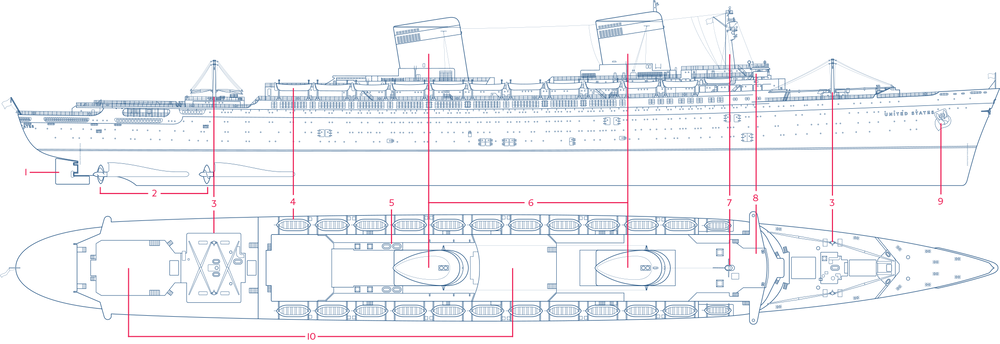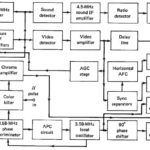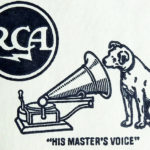Part one looked at the engineering origins of the S.S. United States ocean liner. This part looks at how overall objectives drive the design and engineering of this ocean liner.
Raw power, shape, materials define a new ocean liner
Despite the many maritime-design accomplishments of William Francis Gibbs, they are, in some ways, just small footnotes compared to the realization of his dream: the fastest, sleekest, safest ocean liner ever. This dream became a reality in 1952 with the launch of the S.S. United States, capable of carrying several thousand passengers and crew.
The raw specifications tell much of the story but do not reveal the scope of the innovation, Figure 1. Still, they are a good place to begin: The twelve-deck liner’s overall length was 990 feet (302 m) with a length of 940 feet (287 m) at the waterline; the maximum beam was 101 feet (31 m), and the draft was 32 feet (9.5 m) with displacement at maximum draft over 47,000 tons. The normal ocean-going capacity was 2000 passengers, plus a crew of 900.

The power numbers are truly astonishing. The eight boilers and four 1000-psi steam turbines produced over 240,000 SHP (shaft horsepower, approximately 180,000 kW) to drive four independent propellers, each 18 feet (5.5 m) in diameter. Two of these propellers were four-bladed, and two were five-bladed, which greatly reduced cavitation and resultant ship-wide vibration. Despite the enormous fuel consumption, the ship could carry enough fuel and supplies to travel non-stop up to 12,000 miles (19,000 km) at a cruising speed of 40 mph (65 km/hr).
Much of the superstructure used aluminum to reduce weight, but this brought potential problems of galvanic corrosion, especially in the salt-air environment. To forestall this, Gibbs devised unique metal-metal isolation techniques using specialized barrier tapes and had them adopted by the skeptical shipyard.
Due to the use of aluminum, the liner’s displacement was only about 60% of the similarly sized Queen Mary and Queen Elizabeth liners, and it had the highest power/weight ratio of any comparable vessel. It also significantly lowered the ship’s center of gravity, resulting in better stability. The use of aluminum caused major problems as shipbuilders at that time did not have experience in riveting the metal (and welding was not possible), so new techniques had to be devised for making, annealing, and inserting the aluminum rivets.
Construction took just under three years, and $50 million of its $72 million cost (1950 dollars) was paid for by the U.S. Government to use the liner as a high-speed troopship with a capacity of up to 15,000 soldiers. Navy requirements also mandated that the huge power plant be constructed as two fully independent engine rooms, for redundancy.
The sheer power and innovative use of materials are only part of what distinguished the S.S. United States. Gibbs’ obsession with fire risk led him to enforce a strict design rule: absolutely no flammable material could be used in the construction or decor. The only wood was in the kitchen’s butcher blocks and the dining-room piano (and it was made of fire-resistant mahogany); all fabrics were fiberglass; even the clothes hangers in the guest rooms were aluminum. Even if a fire was started with a match and paper, it would have no nearby fuel to support it.
The power/weight ratio and shaft horsepower were not the only design aspects which allowed the liner to break speed records so effortlessly. The underside of the hull, especially the bow, used an unusual bulbous shape instead of the traditional knife-edge to improve high-speed performance and reduce water resistance and friction (not the first ship to do so, but by far the largest). For many years, this and other below-water details were classified information, and no public drawings or photos below the waterline were available; the many display models of this sleek and modernistic liner showed a flat bottom and no details.
The next part of this article tells the brief life and sad fate of this great ocean liner.
E.E. World References
“Electric locomotives and catenary power systems – Part 1: basic functions”
“RCA & Color T.V.: A dominant company and standard, both now gone – Part 1”
“RCA & Color T.V.: A dominant company and standard, both now gone – Part 2”
External References
- Steven Ujifusa, “A Man and His Ship: America’s Greatest Naval Architect and His Quest to Build the S.S. United States,” Simon and Shuster, 2012
- Steven Ujifusa on William Francis Gibbs and His Ships (podcast and transcript)
- S.S. United States Conservancy , especially the link “The Ship”
- Vox Media, Curbed NY, “Deadline Looms for Historic Ocean Liner’s Move to Brooklyn”
- Cruise Maven, “Crystal Cruises Hopes to Return S.S. United States to Oceangoing Service” (2016)
- Cruise Mapper, “Cruise Ship Design Construction Building”
- Maritime Cyprus, “Ovation of the Seas Floated Out At Meyer Werft Shipyard”
- Cruise Mapper, “Deck Plans”
- Cruise Mapper, “Cruise Ship Engine Power, Propulsion, Fuel”
- The Telegraph, “13 things you didn’t know about cruise ship design”
- Interesting Engineering, “Understanding the Incredible Engineering of Cruise Ships”
- GCaptain, “Ship Engines – 7 Monster Engine Designs, Part 1”
- Carnival Corp., “The Design and Construction of a Modern Cruise Vessel”
- Martin Ottaway, “The Delightful Frustration of Cruise Ship Power Plant Design”






